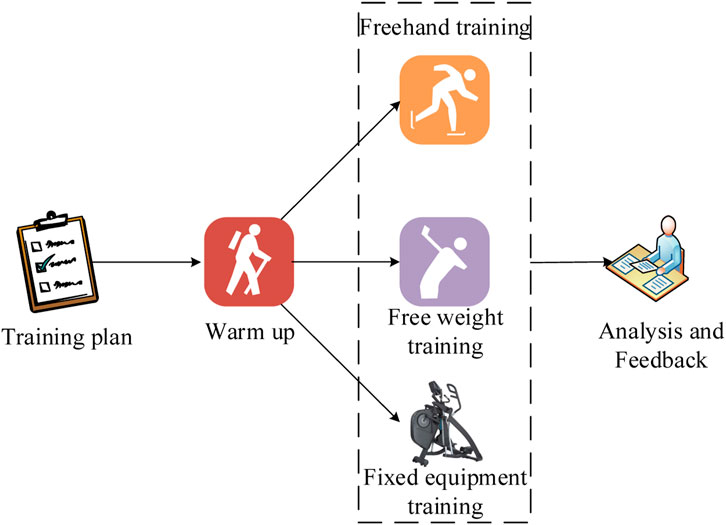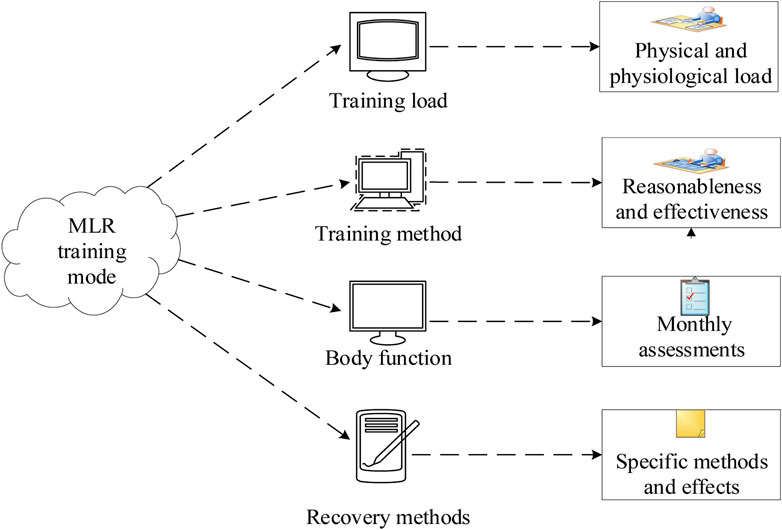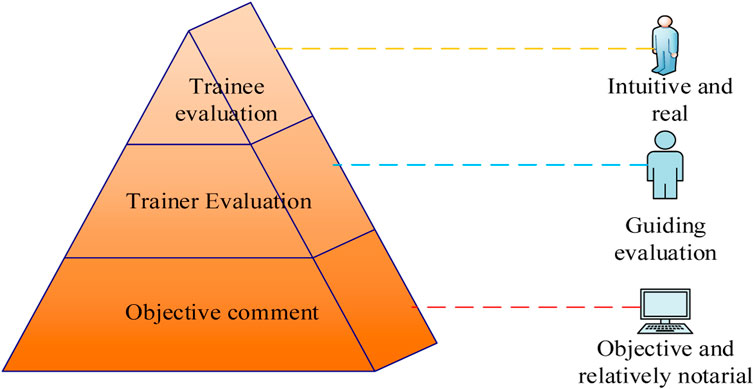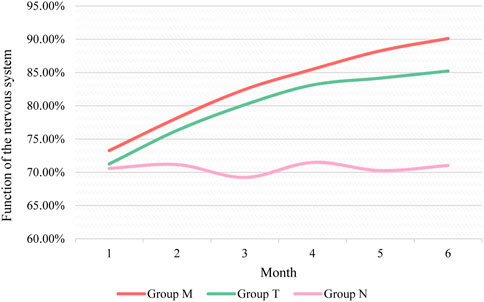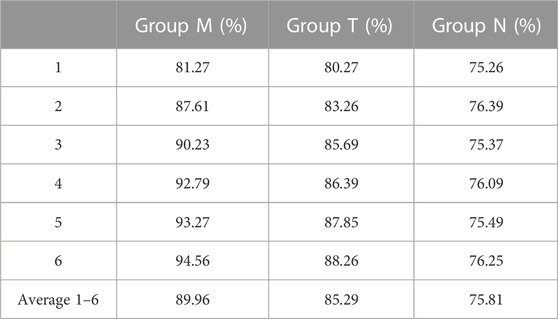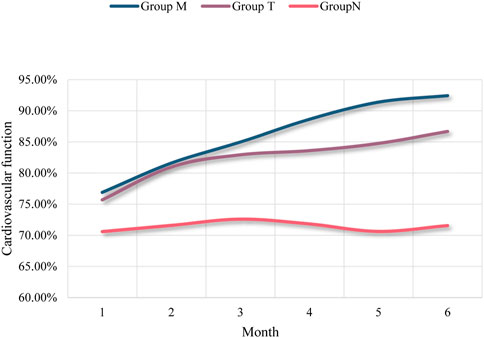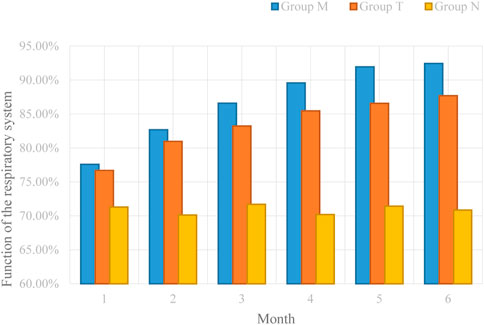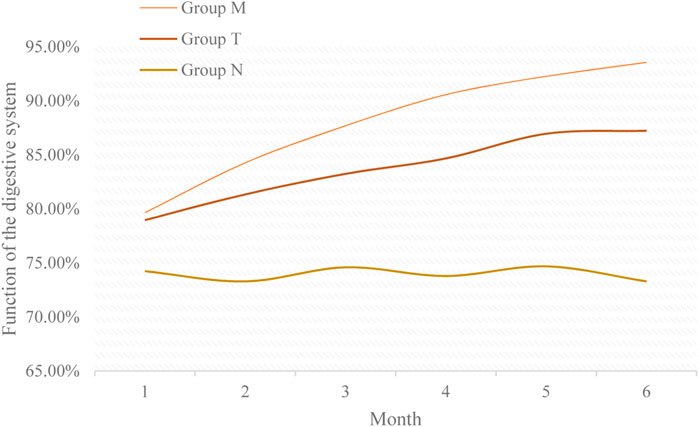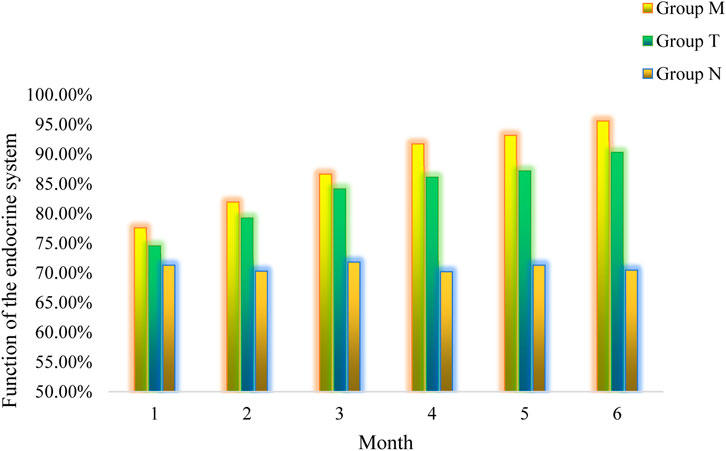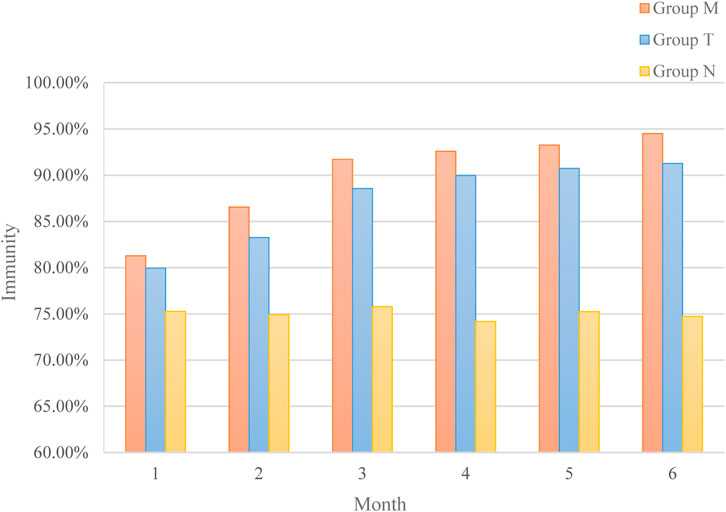Effects of anaerobic exercise training on human function based on multiple linear regression
- 1School of Physical Education, Huizhou University, Huizhou, Guangdong, China
- 2Shandong First Medical University and Shandong Academy of Medical Sciences, Jinan, Shandong, China
In recent years, with the continuous enhancement of people’s fitness awareness, more and more people are doing anaerobic exercise training. Although anaerobic exercise training can improve physical fitness, people also have some problems in anaerobic exercise training due to the lack of necessary exercise training guidance. Therefore, in order to give full play to the role of anaerobic exercise training and enhance human body functions, this paper studies the effects of anaerobic exercise training and anaerobic exercise training on human body functions based on multiple linear regression analysis (MLR). This paper proposes an anaerobic exercise training model based on MLR, and conducts research experiments from seven aspects including exercise capacity, immunity, and cardiovascular function. The experimental results show that the MLR-based anaerobic exercise training mode can improve exercise capacity by 5.48%, immunity by 3.08%, and cardiovascular function by 4.31%.
1 Introduction
With the enhancement of people’s fitness awareness, the phenomenon of anaerobic exercise training is becoming increasingly common. The research on anaerobic exercise training based on MLR can not only better play the role of anaerobic exercise training, enhance human function, but also avoid the occurrence of physical injuries caused by wrong training methods. Therefore, the research in this paper is of practical significance.
Anaerobic exercise training has been studied by many scholars as an effective way to enhance strength and speed. Patel H has proved through experiments that anaerobic exercise training has a significant effect on the prevention of cardiovascular disease, and put forward some method suggestions on anaerobic exercise training [1]. Shi S F studied the effect of anaerobic exercise on the prevention of diabetes. Through experimental research, it was found that anaerobic exercise training can not only effectively prevent diabetes, but also have a significant effect on lowering blood sugar [2]. Dong F analyzed the fitness status of adolescents and put forward some methods for adolescents to carry out anaerobic training by studying the impact of anaerobic exercise on adolescents [3]. Liu R analyzed the influence of anaerobic exercise degree on human muscle groups from a biological point of view, and proposed a training theory about anaerobic exercise based on biology [4]. Ding M X had conducted in-depth research on the form of sports training, and through the comparison of anaerobic exercise training and aerobic exercise training, it was proved that anaerobic exercise training is more effective in improving physical strength and physical fitness [5]. Liang H studied the effect of high-load anaerobic exercise training on the metabolism of free radicals in obese people and proved through experiments that anaerobic exercise training in obese people can accelerate the scavenging of free radicals, thereby reducing body weight [6]. Ni H J analyzed the effect of drinking sugar-sweetened beverages on anaerobic exercise ability and proved through experiments that drinking sugar-sweetened beverages before anaerobic exercise can improve exercisers’ speed and endurance and reduce fatigue [7]. Although scholars have many research theories on anaerobic exercise training, the research on anaerobic exercise training based on MLR is rare.
As a theoretical method to explore the correlation between variables, MLR has been widely used in various research fields. Ameloko A applied MLR to groundwater quality monitoring and established a model for identification, classification, and analysis of groundwater sample data [8]. Yu J X proposed a mathematical model of the low-level calorific value of the washed and blended coal based on MLR, which improved the prediction accuracy of the variation law of the low-level calorific value of the washed and blended coal [9]. Yuan S L applied MLR to the research on the impact of enterprise logistics costs on enterprise benefits and put forward suggestions to reasonably reduce management costs and further improve the logistics system [10]. Li P analyzed the oil and gas operating costs of oilfield companies and established a forecasting model for oil and gas operating costs using MLR by linking production costs, operating costs, and financial indicators [11]. Zhang X T used MLR to study the factors affecting the lumbar bone marrow fat content and concluded that age and visceral fat at the vertebral body level are the key factors affecting the lumbar bone marrow fat content [12]. Xu W put forward the idea of using stone powder as cement admixture through research on stone powder, and used MLR to analyze the effect of stone powder content on the strength of stone powder cement soil [13]. Yang L used MLR to analyze the correlation between the internal structure of agricultural industry and farmers’ wage income, property income, and other sources of income, and proved the correlation between them through experiments [14]. Scholars have applied MLR to many research fields, but there are relatively few research results using MLR to study anaerobic exercise training.
In order to solve the problem that the traditional training mode training concept is relatively backward, this paper studied anaerobic exercise training based on MLR. This way, the effect of anaerobic exercise training can be brought into full play, and the physical fitness and immunity of the athlete can be improved, thereby the risk of disease can be reduced.
2 Anaerobic exercise training mode based on multiple linear regression
1) Training activities under the MLR anaerobic exercise training mode
Long-term anaerobic exercise training can give full play to the role of physical exercise and enhance the physique of trainees [15]. Under the anaerobic exercise training concept of combining work and rest, the functions of anaerobic exercise training can be fully displayed by using scientific and reasonable training methods. Based on this, the training activities under the MLR anaerobic exercise training mode are proposed, as shown in Figure 1.
The training activities in the MLR anaerobic exercise training mode have three processes: before training, during training, and after training, as shown in Figure 1. There are two things need to be aware of before anaerobic exercise training. One is to train according to the guiding concepts and specific training methods under the MLR anaerobic exercise training mode. The other is that a full warm-up must be done before the formal anaerobic exercise training begins. The warm-up time should not be too short, and every part should be carefully exercised during the warm-up. When the anaerobic exercise training officially begins, it is necessary to choose the appropriate type of anaerobic exercise according to the coach or one’s ability. The common types of anaerobic exercise are freehand training, free strength training, and fixed equipment training. Among them, freehand training is less difficult and requires fewer tools, so it is more suitable for beginners. However, the weight of freehand training is the body weight during training, and the effect of training muscles to increase and thicken is relatively limited. Free strength training can involve multiple joints, mobilize more muscle groups, and have a good fat reduction effect, but it is difficult to separate the target muscle groups. Fixed equipment training can separate the target muscle groups and the exercise sense of muscle control, but it requires the cooperation of equipment, and the exercise cost is high. After the anaerobic exercise training, the training plan should be evaluated and feedback in order to optimize the training activities.
2) Monitoring system of anaerobic exercise training mode based on MLR
By observing and monitoring things, it can be better to understand the state of things, to facilitate the research and improvement of things [16]. In order to better study the training activities under the anaerobic exercise training mode, a monitoring system for the anaerobic exercise training mode was established, and the specific content is shown in Figure 2.
The monitoring system of the MLR-based anaerobic exercise training mode includes four monitoring contents: training load, training method, body function, and recovery method, as shown in Figure 2. Training load includes physical load and physiological load. By observing the training load, one can grasp the trainee’s true physical attributes and ability limits. This is not only the premise of extreme training for trainees, but also fully guarantees the physical safety of trainees. The monitoring of the training method is mainly to observe the rationality and effectiveness of the training method to ensure that the method of the MLR anaerobic exercise training mode can be applied in practice. The body function of the trainee is monitored, on the one hand, to understand the physical attributes of the trainee in detail, and on the other hand, it is for the sake of safety. The body function of the trainees is measured in each training session, and a body function assessment test is carried out once a month. Monitoring recovery method is mainly to verify whether specific recovery training methods are effective in practice.
3) Evaluation system of anaerobic exercise training
Evaluating the effectiveness of sports training is of great significance for improving sports training methods [17]. In order to understand the effectiveness of anaerobic exercise training, an evaluation system for anaerobic exercise training was established, as shown in Figure 3.
The evaluation system of anaerobic exercise training includes three contents: trainee evaluation, trainer evaluation, and objective evaluation, as shown in Figure 3. Anaerobic exercise trainees are directly involved in anaerobic exercise training activities, and their evaluation content is more intuitive and real. By evaluating the specific content and methods of anaerobic exercise training, anaerobic exercise trainees can make the trainer constantly adjust the training theory. It can also closely integrate anaerobic exercise training with exercise practice, which is conducive to the improvement of training theory. The trainer evaluation is a guiding evaluation, which is the trainer’s opinion on the content and methods of anaerobic exercise training from the perspective of the instructor. Objective evaluation is the third-party evaluation. The content and methods of anaerobic exercise training can be evaluated by inviting professionals to evaluate, or using mathematical models.
3 Multiple linear regression utilization algorithm
1) Particle swarm optimization algorithm
Particle swarm optimization (PSO) is a class of practical and effective stochastic global optimization techniques [18]. This paper studies PSO in order to solve multiple linear regression analysis problems more efficiently.
It is assumed that the relationships between the dependent variable b and the I independent variables
The MLR mathematical model is represented in matrix form, there are:
Among them,
It is supposed that the search space is E-dimensional with j particles. Particles are searched, there are:
Among them, 1 is the search position of the P-th particle in the E dimension.
The “flying” speed of the p-th particle is:
The optimal position searched by the p-th particle itself is:
The PSO is used to operate on particles there are:
Among them,
2) Constrained overall least squares method
The least squares method is a mathematical tool with the functions of estimating the error and predicting the uncertainty of things [19]. Since the least squares method is susceptible to extreme outliers, in order not to affect the accuracy of the results of anaerobic exercise training research, this paper combined the constrained least squares method and the overall least squares method, and used the constrained overall least squares method to study anaerobic exercise training.
The functional model of constrained overall least squares is:
The stochastic model for constrained overall least squares is:
Among them,
A generalized Lagrangian function is established, there are:
Among them,
It can be derived from the least squares function model and the second derivative matrix:
Among them,
3) Gradient descent algorithm
The gradient descent algorithm can adjust the weights that minimize the loss function by increasing the number of iterations [20]. The gradient descent algorithm is applied to solve the optimal solution of the multivariate linear model.
The loss function in multiple linear regression is:
Among them,
The partial derivative of the mean squared error with respect to each parameter is calculated, then:
In Formula (18),
The expression for finding the minimum point of the loss function combined with the step size is:
Among them,
In the face of a large number of training sets, the gradient is calculated using the stochastic gradient descent algorithm, then there are:
What differences with the gradient descent algorithm is that the stochastic gradient descent algorithm randomly selects an instance of the training set of samples when computing the gradient at each iteration.
4 Experimental purpose and design of multiple linear regression anaerobic exercise training mode
1) Purpose of the experiment
Anaerobic exercise training is studied by using particle swarm optimization algorithm, improved constrained total least squares, and gradient descent algorithm. It is proved that the anaerobic exercise training mode based on MLR can enhance people’s physical function and immunity and reduce the risk of disease.
2) Experimental design
Thirty retired athletes with similar physical abilities were selected and divided into three groups of 10 people each. The first group used the MLR-based anaerobic exercise training mode for anaerobic exercise training, which was called the M group, and this mode was abbreviated as the MLR training mode. The second group was trained using the traditional anaerobic exercise training mode, and this group was called the T group. The third group was used as a control without anaerobic exercise training, which was called the N group. A 6-month experimental study was conducted on three groups of people from seven aspects: nervous system function, exercise ability, cardiovascular function, respiratory system function, digestive system function, endocrine system function, and immune ability. The experimental results were observed and analyzed after the experiment was over.
5 Experimental results of multiple linear regression anaerobic exercise training mode
1) Function of the nervous system
Long-term anaerobic exercise training can improve the function of the nervous system. People who persist in exercising for a long time generally have a faster reaction speed than those who do not exercise. In this paper, the function of the nervous system was studied and the experimental data were recorded. The specific content is shown in Figure 4.
On the whole, the neurological function indexes of the M group were higher than those of the T and N groups, as shown in Figure 4. The nervous system function index of M group and T group was on the rise, and the nervous system function index of N group hovered between 69% and 72%. This showed that anaerobic exercise training can enhance the function of the nervous system, and the MLR training mode was more effective than the traditional anaerobic exercise training mode in increasing the function of the nervous system. The neurological function index of group M was 73.26% in the first month, and that of group T was 71.26%. In increasing the function of the nervous system, the MLR training mode has played a significant role in the first month. The neurological function index of the M group was 90.12% in the sixth month, the T group was 85.23%, and the N group was 71.03%. The effect of MLR training mode on nervous system function was better than that of traditional anaerobic exercise training mode. The monthly average neurological function index of group M was 82.96%, that of group T was 80.04%, and that of group N was 70.63%. It was compared with the group members in the traditional anaerobic exercise training mode, the average nervous system function of the group members in the MLR training mode increased by 3.65%. It was compared with the group members who did not perform anaerobic training, their average nervous system function improved by 17.46%.
2) Athletic ability
Exercise ability is an intuitive display of human body function. The improvement of exercise ability can enhance people’s vitality and improve life happiness. Long-term anaerobic exercise training can increase bone strength and increase muscle strength. It not only enhances physical strength and improves athletic ability, but also increases the width of the rib cage for better body shape. The research contents on exercise ability are shown in Table 1 and Figure 5.
On the whole, the exercise ability indicators of the M group and the T group were in an increasing trend, as shown in Table 1 and Figure 5. The exercise capacity index of group N did not show an increasing trend, but hovered between 75% and 77%. From the data results, the exercise ability of the M group reached 90.23% in the third month, while the exercise ability index of the T group did not reach more than 90% even in the sixth month. The exercise capacity of the M group was 94.56% at the sixth month, and the T group was 88.26%. It showed that the MLR training mode was better than the traditional anaerobic exercise training mode in improving athletic ability. The average exercise capacity of group M was 89.96%, that of group T was 85.29%, and that of group N was 75.81%. It was compared with the group members in the traditional anaerobic exercise training mode, the average exercise capacity of the group members in the MLR training mode increased by 5.48%, and the average exercise capacity of the group members without anaerobic training increased by 18.67%. This showed that the MLR training mode can not only enhance people’s athletic ability, but also has a significant effect on enhancing athletic ability. It was compared with the group without anaerobic training, the average exercise capacity of the group members in the traditional anaerobic exercise training mode increased by 12.5%. Anaerobic exercise training can indeed enhance a person’s physique and improve athletic ability.
3) Cardiovascular function
Performing anaerobic exercise training can increase the heartbeat intensity and improve heart function. It can also maintain the vitality of blood vessels and lymphatic vessels, and improve the function of delivering nutrients to the human body. The specific content of cardiovascular function is shown in Figure 6.
It can be seen in Figure 6, the cardiovascular function of the M group was 76.89% in the first month and 92.42% in the last first month. The cardiovascular function of the T group in the first month and the sixth month was 75.69% and 86.67%, respectively. The cardiovascular function of group N in the first month and the sixth month was 70.59% and 71.56%, respectively. Compared with the original, the cardiovascular function of the M group and the T group increased by 15.53% and 10.98%, respectively. The cardiovascular function of the N group did not change much and remained between 70% and 73%. The average cardiovascular function of group M was 85.98%, that of group T was 82.43%, and that of group N was 71.46%. The cardiovascular function of the group members in the traditional anaerobic exercise training mode was 15.35% higher than that of the group members without anaerobic exercise training. The cardiovascular function of the group members in the MLR training mode was 4.31% higher than that of the group members in the traditional anaerobic exercise training mode.
It was compared with the group members who did not do anaerobic exercise training, the cardiovascular function of the group members who did anaerobic exercise training was significantly improved, indicating that anaerobic exercise has a considerable effect on enhancing cardiovascular function. It was compared with the group members in the traditional anaerobic exercise training mode, the group members in the MLR training mode played a more effective role in enhancing cardiovascular function.
4) Function of the respiratory system
Anaerobic exercise training can promote the good development of the thorax and lungs and enhance the strength of respiratory muscles, as well as improve lung capacity. In this paper, the functional indicators of the respiratory system were analyzed, and the specific content is shown in Figure 7.
It can be seen in Figure 7, at the first month, the respiratory system function of the M group and the T group changed significantly compared with the N group that did not exercise. The respiratory system function of the T group was 5.4% higher than that of the N group, and the respiratory system function of the M group was 6.3% higher than that of the N group. The effect of anaerobic exercise training was more obvious in the first month. From the final results, the respiratory system function of the M group was 92.43% at the seventh month, and the respiratory system function of the T group was 87.69%. In terms of improving the function of the human respiratory system, the MLR training mode was better than the traditional anaerobic exercise training mode in terms of initial performance and final results. The average respiratory system function of the M group was 86.8%, and that of the T group was 83.43%. The respiratory system function of the group members in the MLR training mode was 4.04% higher than that of the group members in the traditional anaerobic exercise training mode.
5) Function of the digestive system
The digestive system is responsible for nutrient intake and largely determines the health of the human body. Anaerobic exercise training can enhance the function of the digestive system. In this paper, the functional indicators of the digestive system were analyzed, and the specific content is shown in Figure 8.
It can be seen in Figure 8, the digestive system functions of the M group and the T group were 79.65% and 78.96% in the first month, respectively, and the N group was 74.23%. Anaerobic exercise training was effective in enhancing the digestive system function. The average digestive system function of group M was 88%, that of group T was 83.73%, and that of group N was 73.98%. In terms of digestive system function, the group members in the MLR training mode were 4.04% higher than those in the traditional anaerobic exercise training mode, and 5.1% higher than those who did not do anaerobic exercise training. The MLR training mode can better exert the actual effect of anaerobic exercise training in improving the function of the digestive system.
6) Function of the endocrine system
The endocrine system controls the body’s physiological processes through hormones. Proper anaerobic exercise training not only ensures the proper secretion of hormones, but also enhances the regulation effect of hormones on human body function. This paper analyzed the functional indicators of the endocrine system, and the specific content is shown in Figure 9.
It can be seen in Figure 9, compared with the members of the N group who did not perform anaerobic exercise training, the endocrine system functions of the members of the M and T groups who received anaerobic exercise training increased significantly. The endocrine system function of the N group in the first month was 71.29%, and the average endocrine system function was 70.89%. The endocrine system function of the T group in the first month was 74.57%, and the average endocrine system function was 83.6%. The endocrine system function of the M group in the first month was 77.59%, and the average endocrine system function was 87.77%. The endocrine system function of the M group in the first month was 3.02% higher than that of the T group, and 6.3% higher than that of the N group. This showed that the MLR training mode was not only effective in improving the function of the endocrine system, but also in practice this effect was exerted faster. The average endocrine system function of the M group was 4.99% higher than that of the T group, and 23.81% higher than that of the N group. It was combined with the change trend of the endocrine system function of the three groups of members, the MLR training mode can not only play the promoting effect of anaerobic exercise on the endocrine system function, but also has stability in maintaining this promoting effect.
7) Immunity ability
Anaerobic exercise training can enhance people’s physical fitness and improve immunity, as well as reduce the risk of disease. The specific content of immunity is shown in Figure 10.
It can be seen from Figure 10, the immunity of the members of the M group and the T group was higher than that of the N group members, and the immunity of the M group members was higher than that of the T group members. In terms of the changing trend of immunity, the immunity of M group members and T group members has always been in a stable growth trend. The immunity of the N group members showed a “wave-like” trend, and the immunity of the N group members did not increase to a great extent. From the results of immunity, the immunity of M group members in the sixth month was 94.49%, and the average immunity was 89.99%. The immunity and average immunity of T group members in the sixth month were 91.27% and 87.3%, respectively. The immunity and average immunity of N group members in the sixth month were 74.73% and 75.03%, respectively. In terms of immunity, the group members in the MLR training mode were 3.08% higher than those in the traditional anaerobic exercise training mode, and 19.94% higher than those who did not do anaerobic exercise training. It was proved that the MLR training mode can effectively enhance immunity in practice and is reliable.
6 Conclusion
There are two problems with anaerobic training. One is the problem that incorrect exercise methods and unhealthy exercise concepts can cause damage to the body. Another problem is that the training concept of the traditional training mode is relatively backward, and the guiding effect of anaerobic exercise training practice is not obvious. In order to solve these two problems, protect the health of trainees, and give play to the effect of anaerobic exercise training to enhance physical function, this paper studied the effects of anaerobic exercise training and anaerobic exercise training on human function based on multiple linear regression analysis. An anaerobic exercise training mode based on MLR was proposed, and the experiment proved that the MLR anaerobic exercise training mode can effectively improve human performance. The trainee’s exercise capacity and immunity have been enhanced, and cardiovascular function has also improved.
Data availability statement
The original contributions presented in the study are included in the article/supplementary material, further inquiries can be directed to the corresponding author.
Author contributions
HX and KP writing and static analysis of data LS and FP-experimental operation and check. All authors contributed to the article and approved the submitted version.
Funding
This work was supported by the Funding Agency: 2020 Philosophy and Social Science Planning project of Guangdong Province, “Research on Operation Management and Optimal Path Selection of Sports Characteristic Towns in Guangdong-Hong Kong-Macao Greater Bay Area” (No. GD20CTY10).
Conflict of interest
The authors declare that the research was conducted in the absence of any commercial or financial relationships that could be construed as a potential conflict of interest.
Publisher’s note
All claims expressed in this article are solely those of the authors and do not necessarily represent those of their affiliated organizations, or those of the publisher, the editors and the reviewers. Any product that may be evaluated in this article, or claim that may be made by its manufacturer, is not guaranteed or endorsed by the publisher.
References
1. PatelAlkhawamMadanieh HHR, Shah N, Kosmas CE, Vittorio TJ. Aerobic vs anaerobic exercise training effects on the cardiovascular system. World J Cardiol (2017) 9(2):134–8. doi:10.4330/wjc.v9.i2.134
2. Shi SF. Anaerobic exercise to raise or lower blood sugar. Med Diet Health Care (2017) 75(11):47–8.
4. Liu R. Research on the theoretical mechanism and practice of anaerobic exercise training. J Suzhou Inst Educ (2018) 21(3):153–4.
5. Ding MX. Talking about the training of aerobic and anaerobic exercise. New Campus: Early Issue (2017) 90(2):112–3.
6. Liang H. Effects of high-load anaerobic exercise training on free radical metabolism in obese people. Sci Technol Eng (2017) 17(21):217–21.
7. Ni HJ. The effect of supplementing different concentrations of sugar-sweetened beverages before exercise on human anaerobic exercise capacity. Farm Staff (2019) 636(21):184–237.
8. Ameloko AA, Ayolabi EA. Estimation of total dissolved solid in groundwater using multiple linear regression analysis around Igando dumpsites in Lagos, South-West, Nigeria. Case Study Groundwater Pollut (2017) 16(3):13–27.
9. Yu JX. Mathematical model of low calorific value of washed and blended coal by multiple linear regression analysis method. Coal Technol (2017) 115(7):287–9.
10. Yuan SL. Multiple linear regression analysis of the impact of enterprise logistics cost on enterprise benefit. Stat Decision-Making (2019) 44(4):186–8.
11. Li P, Mao Q, Wang XX. Establishment and application of operating cost prediction model based on multiple linear regression analysis. Pet Plann Des (2018) 29(3):33–7.
12. Zhang XT, Zhao YX, Li MW. Multiple linear regression analysis of lumbar bone marrow fat content to assess osteoporosis and its influencing factors. J Pract Radiol (2021) 37(1):102–6.
13. Xu W. Orthogonal test and multiple linear regression analysis of compressive strength of stone powder cement soil. Eng Technol Res (2019) 17(7):21–3.
14. Yang L. Multiple linear regression analysis of the impact of agricultural industrial structure on farmers' income. Stat Decis (2017) 27(17):118–20.
15. Wang ZG, Xu SJ, Ding MC. Effects of different weights on the mobility of explosive and anaerobic exercise. Bull Sports Sci Technol Lit (2017) 25(6):60–125.
16. Xu Z, Kamruzzaman MM, Shi J. Method of generating face image based on text description of generating adversarial network. J Electron Imaging (2022) 31(5):051411. doi:10.1117/1.jei.31.5.051411
17. Cheng X. Research on the evaluation of special training effects for youth competitive aerobics athletes. Youth Sports (2018) 20(3):33–4.
18. Li F, Liu JC, Shi HT. Multi-objective particle swarm optimization algorithm based on decomposition and differential evolution. Control Decis (2017) 32(3):403–10.
19. Deepak Kumar J, Zareapoor M, Jain R, Kathuria A, Bachhety S. GAN-poser: An improvised bidirectional gan model for human motion prediction. Neural Comput Appl (2020) 32(18):14579–91. doi:10.1007/s00521-020-04941-4
Keywords: anaerobic exercise training, human function, multiple linear regression analysis, traditional anaerobic exercise training mod, physical fitness
Citation: Xiao H, Peng K, Sun L and Pan F (2023) Effects of anaerobic exercise training on human function based on multiple linear regression. Front. Phys. 11:1168765. doi: 10.3389/fphy.2023.1168765
Received: 18 February 2023; Accepted: 27 March 2023;
Published: 05 April 2023.
Edited by:
Amrit Mukherjee, University of South Bohemia in České Budějovice, CzechiaReviewed by:
Youbao Ma, Zhejiang University of Technology, ChinaNengyun Zhang, Ningbo University, China
Copyright © 2023 Xiao, Peng, Sun and Pan. This is an open-access article distributed under the terms of the Creative Commons Attribution License (CC BY). The use, distribution or reproduction in other forums is permitted, provided the original author(s) and the copyright owner(s) are credited and that the original publication in this journal is cited, in accordance with accepted academic practice. No use, distribution or reproduction is permitted which does not comply with these terms.
*Correspondence: Feng Pan, fpan@sdfmu.edu.cn
 Haiting Xiao1
Haiting Xiao1  Feng Pan
Feng Pan